Sights and Activities
Below are the places we saw and activities completed while visiting Japan:
Ferry to Japan
We took a relaxing boat ride from Shanghai, China to Osaka, Japan. The voyage lasted two days and two nights. It was a great break from our usual sightseeing and activity driven itinerary. We arrived to Japan well rested and ready to discover the islands of this eastern Asian country.
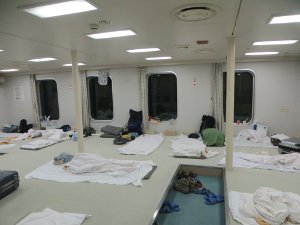
Osaka
Osaka Museum of History: we viewed the museum’s permanent exhibit that led us through the past and present of the city. The museum also had a special exhibition titled Evangelion and Japanese Swords that featured various swords used for manga characters.
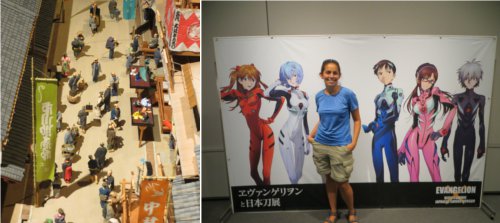
The Japanese Garden: we visited this large traditional garden with ponds, rocks, trees, rivers, and many more other traditional features.
Osaka-jo Castle: this castle was built by Toyotomi Hideyoshi after he achieved his goal of unifying Japan. It took three years and one hundred thousand workers to finish the original castle by 1583. However, it was destroyed just 32 years later by the armies of Tokugawa Ieyasu. It was rebuilt 10 years later only to suffer another disaster in 1868. The present structure is a 1931 concrete reconstruction of the original, which was refurbished in 1997.


Ichijima
We had a great opportunity to WWOOF in this small town. Shinjin and Keiko run a farm of vegetables and chickens that belongs to a Community Support Agricultural with two other local farms. In addition to experience the life of a Japanese farmer, we had the chance to learn about the science of farming, practice yoga, meditation, great conversations, and other great experiences. Be sure to read our article to learn more about our experience.
Tsu
We briefly visited this city to see a family friend, Father Wil. He kindly drove us around to show us the highlights of the town, which included a city park where we were able to feed coy fish and turtles, the port, and a fabulous beach where we enjoyed the sunset.
Tokyo
Kabuki-Za Theater: We enjoyed one act of a Kabuki show in this newly renovated theater. With an audio translator we were able to appreciate the storyline and actor’s talent of the show.
Tokyo National Museum: this museum features building from the 1930’s and four main galleries. The galleries introduced us into Japanese art history, ancient pottery, Buddhist sculptures, lacquerware, and calligraphy.
Sensoji Temple: the present temple dates from 1950 and enshrines a golden image of Kannon, the Buddhist Goddess of Mercy.
Tokyo Sky Tree Building: we had great views from a nearby river of one of the world’s highest towers, 634m, 2,080ft.
Asahi Flame Building: along the same building skyline as the Sky Tree, this beer building features an artistic interpretation of the foam at the top of a glass of beer on top of the building.
Tsukiji Fish Market: we were able to witness giant tuna fish being sold in an auction in the world’s biggest seafood market. We were also able to feast on fresh sushi at one of the market restaurants.
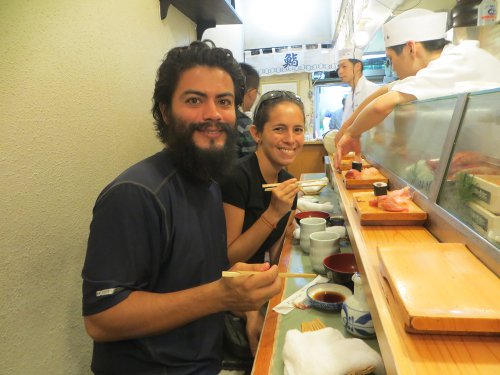
Hama-rikyu Gardens: these beautiful grounds feature gentle rolling hills, ponds, well pruned trees, beautiful flowers, and tea houses surrounded by modern buildings. We enjoyed the gardens with a complimentary, well-designed audio tour that uses GPS technology to automatically narrate facts and stories about the surroundings.
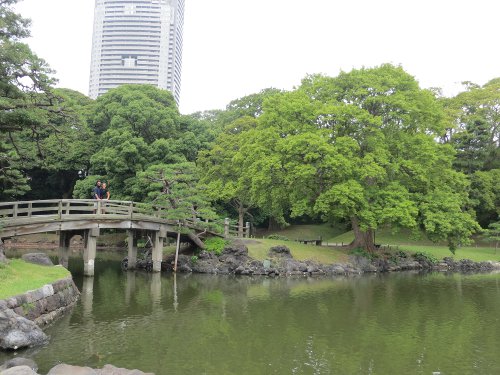

Imperial Palace and Gardens: the palace, located in the center of Tokyo, is home to Japan’s emperor and imperial family, therefore it is closed to the public. We were able get views of the palace from the surrounding gardens.
Shibuya Crossing: one of the world’s busiest pedestrian intersections with an estimated 100,000 people passing through every hour. We were able to people watch from the ground and at bird’s eye level from a nearby building.
Takaragawa Onsen: arguably one of Japan’s best outdoor hot springs was a great break from sightseeing in the city. This was our first onsen experience in Japan and after the great time, it wasn’t our last. The onsen featured three hot pools adjacent to a river with beautiful landscapes.
Meiji-jingu Shrine: the original was completed in 1920, but destroyed during World War II. The current one was rebuilt in 1958. This is Tokyo’s largest Shinto shrine and boasts the nation’s largest torii, shrine gates.
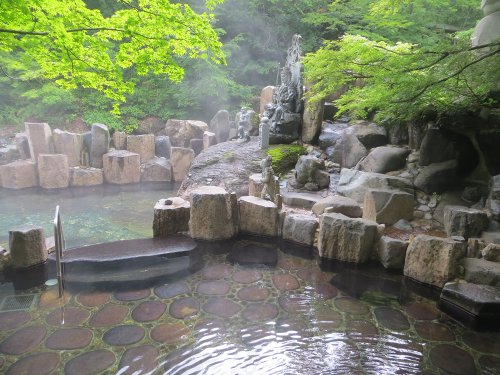

Tokyo Dome: home of the Japan’s favorite baseball team, the Yomiuri Giants. We had the opportunity to watch them play against their rival team, the Swallows. The stadium was full of excitement with fans’ unique chants, beer girls running down the aisles with kegs on their backs, business men in suits, and of course the game, all had us entertained.
Mount Fuji: we spent a long day hiking up Japan’s dormant volcano and highest mountain at 3,776m (12,388 ft). The 14-hour day began by taking a bus to Mount Fuji 5th Station where we started on the Yoshida trail for our five-hour ascend to the summit. The hike up was strenuous passing through lava rocks and sometimes climbing on all four limbs, but the views were all worth it. We were rewarded at the summit with views looking down into oceans of clouds. The hike back down was also very steep and full of loose rocks.

Cheering in the Tokyo Dome
Sapporo
Sapporo Beer Festival: we were in town for this month-long festival that takes place in Odori Koen, a local park. We tasted Kirin, Asahi, Sapporo, and Suntori beers the two times we attended.
Ni-jo Ichiba Market: we enjoyed a sushi breakfast of the local specialties: sea urchin, crab, salmon, and salmon eggs.
Sapporo-shi Tokei-dai (Clock Tower): this is the city’s signature landmark, built in 1878.
Noboribetsu Onsen: this hot-springs city has more than two dozen bathhouses. We went to Dai-chi Takimoto-kan Onsen with over 15 indoor and outdoor pools all featuring different temperatures and minerals.
Asahikawa: we took a day trip to this central Hokkaido city and went to Kawamura Kaneto Ainu Kinenkan, the first Ainu Museum founded by Kaneto Kawamura, an Ainu chief. We also visited a couple of sake breweries: Otokoyama Jyozo and Takasago Meiji Jyozo. We ended the day trip by having a beer tasting at Taisetsu Ji Beer Micro Brewery.
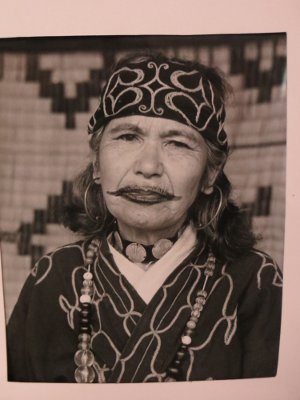
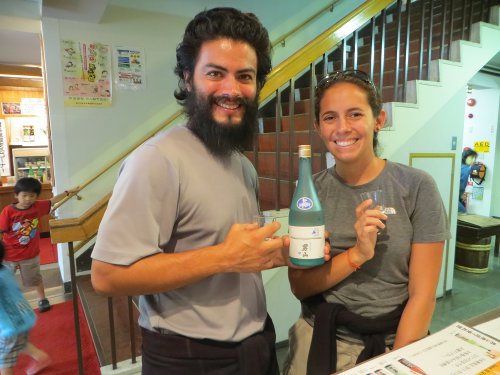
Hokkaido Ainu Kyokai Cultural Center: this cultural center offers a display room of artifacts and historical information of the Ainu. We watched videos about the oppression of the Ainu people and how they are now trying to regain their culture and land. Ainu culture was once declared “dead” by the Japanese government, but the past few decades have seen people of Ainu descent assert their ethnicity both politically and culturally. It was once the standard among people of Ainu descent to hide their ethnicity out of fear of discrimination in housing, schools and employment. Now the law allocates government funds for Ainu research and the promotion of Ainu language and culture, as well as better education about Ainu traditions in state schools. “Ainu” means human being in their language.
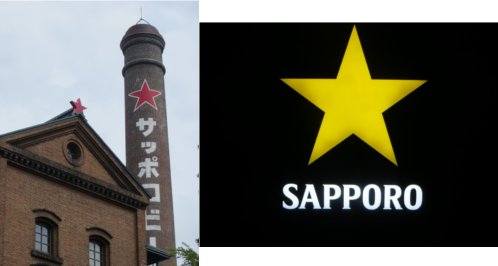
Sapporo Beer Brewery: Japan’s first beer brewery founded in 1876 also hosts a beer museum. Unfortunately, most of the museum was in Japanese, but we enjoyed a great tasting of three their beers.
Magome and Tsumago
We spent a couple of days in these traditional, preserved Japanese towns where we enjoyed the scenery, traditional meals, bath, and more. Be sure to read our article on this traditional Japanese experience.
Kyoto
Lake Biwa: we were fortunate to have accommodation in Kyoto along the shores and with great views of the largest lake in Japan.
Fushimi-Inari Taisha Shrine: this shrine complex was dedicated to the gods of rice and sake in the 8th century. Nowadays, the shrine is one of Japan’s most popular, and is the head shrine for some 30,000 Inari shrines scattered throughout Japan. The complex is full of pathways lined with thousands of orange tori (shrine gates) that lead into mountains and forests. There are also dozens of stone foxes, which are considered messengers of Inari, the god of the rice harvest.


Kurama-dera Temple: we took a tram up to the main temple surrounded by a beautiful forest full of towering trees. The temple was established in 770 and it describes its own brand of Buddhism as Kurama Kyo.
Kurama Onsen: compared to other onsens we visited, this one was smaller, but still was a great way to relax. The indoor bathhouse had one hot and cold pool.
Nijo-jo Castle: we visited the inside of this castle that was built in 1603. The floors were constructed with a technique known as ‘nightingale’, where the planks were designed to squeak when walked on. This would warn the emperor of any intruders.
Kinkaku-ji Temple: home of the Golden Pavilion that sits adjacent to a picturesque pond.
Ryoan-ji Temple: this is a Zen temple with the main attraction being a garden with 15 rocks.
Sanjusangen-do Temple: this temple houses 1,001 statues of the 1000-armed Kannon (the Buddhist goddess of mercy).
Kiyomizu-dera Temple: this large complex contains an ancient temple that was first built in 798, but the present buildings are reconstructions dating from 1633. The main hall has a huge balcony with great mountain views. A waterfall was located below the hall, where visitors drink sacred waters believed to bestow health and longevity.
Gion Corner: we viewed a show of Traditional Japanese arts: Tea Ceremony (Chado), Japanese Harp Demonstration (Koto), Flower Arrangement (Kado), Court Music (Gagaku), Ancient Comic Play (Kyogen), Kyoto Style Dance (Kyomai), and Puppet Play (Bunraku). Although the performance tried to cram several acts in a short period of time, it was a good introduction to Japanese arts.
Tenry-ji Temple: this temple’s main feature is a 14th century water pond Zen garden.
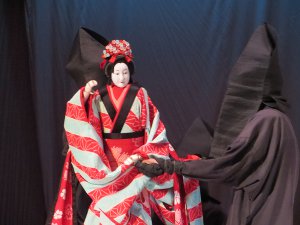
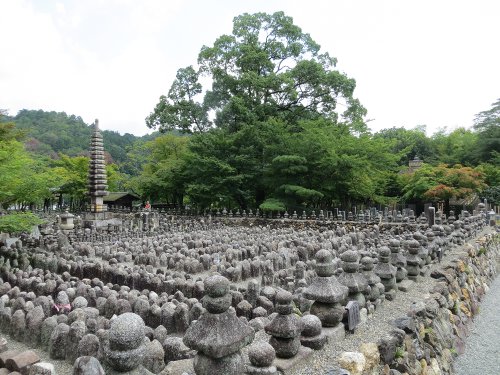
Arashiyama Bamboo Grove: we walked through this refreshing grove full of towering bamboo.
Gio-ji Temple: this quiet temple featured a lovely expanse of moss that lay on the ground and bottom of tree forest.
Adashino Nembutsu-ji Temple: this temple contained a stone Buddha surrounded by eight thousand stones and a stone pagoda. The complex also contained a nice bamboo grove that lead to a cemetery.
Ginkaku-ji Temple: this Zen temple was full of beautiful gardens, which included a set of raked cones of white sand said to be symbolic of a mountain and a lake.
Tetsugaku-no-michi (Path of Philosophy): this peaceful pedestrian path runs along a canal that is lined with blooming trees and flowers. It takes its name from one of its most famous strollers: 20th-century philosopher Nishida Kitaro, who is said to have meandered along the path lost in thought.
Nanzen-ji Temple: this temple features many Zen gardens and flowers. Especially interesting, was the Leaping Tiger Garden, a classic Zen garden.


Hiroshima
Atomic Bomb Dome: originally built in 1915, it is now a grave reminder of the atomic bomb. All that is left are ruins of a building that was near the hypocenter of the a-bomb. Everyone inside was killed, but the building itself was one of very few left standing anywhere near the epicenter. A decision was taken after the war to preserve the shell of the building as a memorial. It is now declared a Unesco World Heritage Site.
Peace Memorial Park: full of different memorials including the cenotaph, which contains the names of all the known victims of the atomic bomb; the cenotaph frames the Flame of Peace, which will only be extinguished once the last nuclear weapon on earth has been destroyed; and the Children’s Peace Monument, inspired by an 11-year-old girl that developed leukemia due to the radiation and decided to fold 1,000 paper cranes in hope that she would recover, unfortunately she died before reaching her goal, but her classmates folded the rest of them.

Hiroshima National Peace Memorial Hall for the Atomic Bomb Victims: the entrance encircles an underground hall of remembrance which leads to a room where the names and photographs of the victims are kept. We listened to a few testimonials of the survivors that painted a vivid picture of the chaos and panic during that period.
Peace Memorial Museum: the museum starts by presenting the history and living conditions of the city prior to the World War II and continues with the history of Japanese war from the Japanese invasion of China and eventually into WWII. The museum had two interesting models of the city prior and after the atomic bomb that displays the size and distance of detonation of the bomb, as well as aftermath. There was a depressing exhibition showing the development of more nuclear weapons in the years since and the display of 604 letters written by both mayors of Hiroshima and Nagasaki to world leaders begging to stop nuclear testing. There were also several rooms filled with salvaged items from the devastation including ragged clothes, glasses, and a child’s melted lunch box. Lastly, we watched two films: Hiroshima and Nagasaki – The Harvest of Nuclear War: that displayed devastating footage of victims, survivors, and the effects of radiation on humans; and Hiroshima – A Mother’s Prayer: presenting strong graphics of the children victims and the after effects years later such as leukemia and other cancers.
Our visit to Hiroshima inspired us to write about our experience to be sure we do not forget the horrible tragedy that occurred, please be sure to read our article.
Yoshii
Our second WWOOFing experience in Japan, was with the Adachi family. Yoshi runs a blueberry and persimmon farm that belonged to his parents. His mother, known to us as Obaachan (grandmother), with all her energy is the life of the family. While having a great time learning all about blueberries, from making wine, cake, jam, and of course savoring the blueberries themselves, we were able to connect with our Japanese family. Be sure to read our article to learn more about our experience.
Trains, Trains, Trains!!
We spent most our commuting hours on trains in Japan. They have one of the most efficient and precise train systems in the world. Whether on a tram, subway, local train, or a shinkansen you can always count on them being on time. We spent about 43 hours traveling between cities on trains plus countless hours on local trains and subways and only once did a train get cancelled, and that was due to bad weather!!

